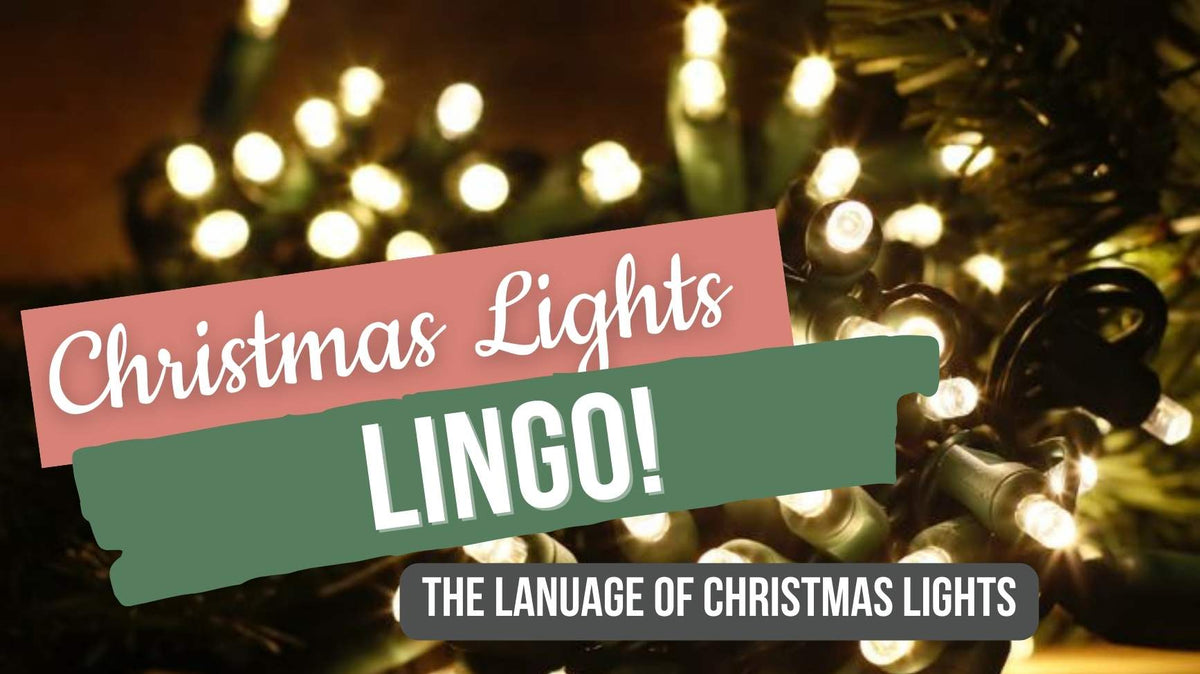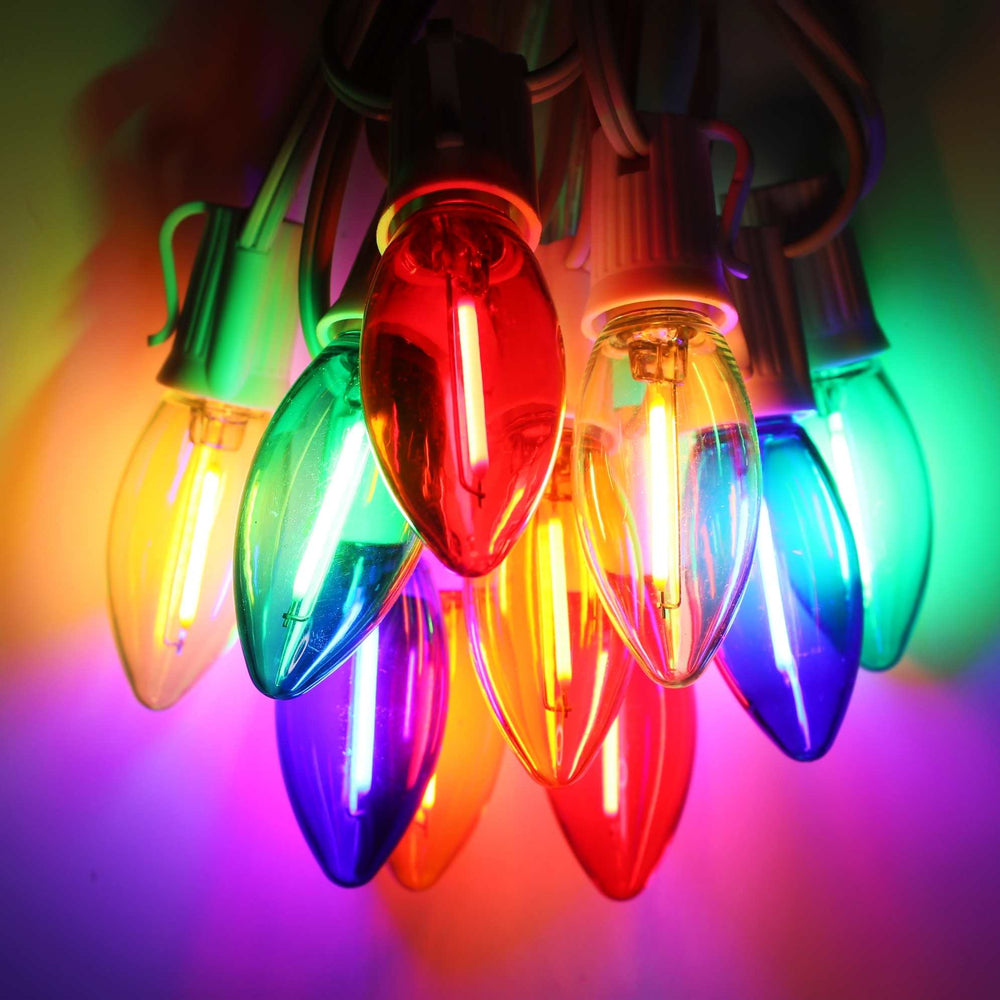

Common Christmas Lights Terminology and Vocabulary
5mm
This is a shape of LED lens that is about the shape of and slightly smaller than a pencil eraser. It has been referred to as "wide angle" and "conical" in the past since there is a cone shape molded into the lens to reflect out a maximum amount of light. This lens style appears to be the brightest of the LED mini light strings since it concentrates lights so well.
Amp
A measure of current. If electricity is compared to water, this specification would measure the rate of water through a hose. The more light strings run in series, the greater the current flow. That's why running too many light sets in series will break or "blow" the fuse.
Amp usage
How much current a string of lights or bulb "pulls" or requires based on its electrical resistance. Important to keep track of so the max amperage rating of an electrical breaker or the light strings or blbs aren't exceeded.
Bulb Voltage
While bulbs in the US run on 110/120 volts, they also have a specified voltage drop. Use this specification when replacing glass mini light bulbs to make sure replacement bulbs match what they are replacing. Mismatched replacement bulbs will either put out very little light or burn bright and die.
C6
Smallest of the cone shaped LED lenses. 6/8 of an inch in diameter.
C7, C9
Traditional-sized Christmas light bulbs. They have threaded bases and are manufactured to install in standard C7 or C9 Christmas light cords with E12 or E17 sockets respectively.
Candelabra
Another name for E12, the size of the socket or base of a C7 Christmas light bulb.
Craft Lights
Lights tailored to installed in bottles and blocks commonly having only a single male plug.
Curtain Lights
Sets of lights shaped like traditional icicle lights. Instead of staggered lengths of "icicles" all of the legs are the same length - generally 5' or longer. Available in glass and LED.
Dimmable
Light bulbs and strings are designed to respond linearly to changes in voltage. This means that they'll dim when connected to a dimming switch. For bulbs, non-dimmable indicates that they won't respond as expected to a dimming switch - they may be on then just off instead of smoothly ramping from on to off. Non-dimmable bulbs are also not suited to displays that rapidly flash on and off which will damage them almost immediately.
Drops
The portions of light strings forming vertical legs on icicle and curtain lights.
E12, E17, or E26
The measure of the size of light cord sockets. E12 = C7 = Candelabra, E17 = C9 = Intermediate, E26 = Medium. See this blog post for more discussion.
End to End
Indicates a light string has a male plug on one end and a female plug on the other, and the light sets can be connected one into another - i.e. "end to end."
Flicker
The flashing that is visually perceptible in LED lights that are not adequately rectified. The waveform of the AC electricity causes the LEDs to turn off and on fast but not so fast that your eye and sometimes your stomach isn't bothered by it.
Full Wave Rectified
Electrical devices that have circuits that smooth and filter an AC input electricity waveform to prevent noticeable flicker.
G12, G30, G40, G50
Sizes of round "globe" bulbs. Available in both glass and LED. The number is the diameter of the bulb in millimeters.
Head Wire/Lead Wire
Length of wire between the male or female plug and the first or last bulb, respectively. This length can range from identical to the distance between bulbs to much longer based on the light string's intended application.
Icicle Lights
Traditional retro Christmas lights that are manufactured with a single central cord that multiple "legs" of lights hang from. Installed along a roofline they are evocative of real icicles.
Indoor/Outdoor Rated
Specification indicating where a light string, bulb, or accessory can be used.
Intermediate
Another name for a C9 or E17 socket size. Can also refer to the size of the base of the bulb.
LED
A small device that produces lights with semiconductors instead of heating a metallic filament like incandescent bulbs.
LED Christmas Lights
Light strings and bulbs that produce lights with semiconductors instead of filament. Sensitive to impulses on electrical lines, they should always be plugged into a surge protector. Using a fraction of the electricity of their glass counterparts, LED Christmas lights have surged in popularity over the last 15 years and dominate the Christimas lighting marketplace.
Lumens
The measure of perceived brightness at 36 inches of a bulb or light string.
Lifetime hours
An approximate number of hours a Christmas light string would operate in perfect conditions. Used to compare different brands of bulbs or cords but not intended to be a warranty or promise. (Like MPG is for cars.)
M5
A small LED lens shape that is textured to look like an actual small frozen icicle.
Magnetic Clips
Clips that contain rare earth magnets designed to fit onto the bottom of traditional C7 or C9 Christmas light cord sockets. Use them to install lights on metal surfaces. Always test with a household magnet before ordering.
Maximum Connectivity
The maximum number of light strings that can be connected in series. Exceeding this number creates and electrical hazard, blows fuses, and should be avoided during installation.
Mini Lights
Traditional glass or LED light strings are used commonly to light Christmas trees. Uses for them have extended outside the Christmas season to include parties and events. Wired in series, this type of light string cannot be cut or modified and retain its electrical integrity.
Net Light
Hand-tied light strings with bulbs spaced evenly in squares forming large rectangles of lights that are ideal for decorating shrubbery. Available in glass and LED.
Nickel Base
Common plated finish on C7 and C9 Christmas bulb bases. Usually plated over brass. The finish of similar bulbs - for example, pure and warm white bulbs look the same when not powered on - is sometimes varied for easy sorting.
Parallel Wired
Refers to how traditional 18 AWG Christmas light cords are electrically manufactured with constant voltage allowing them to be cut to fit.
Series Wired
Strings of lights usually employ a 2 or 3-wire harness and are electrically manufactured to be constant current. Cannot be cut to fit.
SPT-1 or SPT-2
Specification related to the thickness of insulation on 18 AWG traditional Christmas light cords. SPT-2 is slightly thicker than SPT-1 and intended for use in slightly more rugged conditions. Both types of cord are rated at 10 amps.
Stackable Plug
Male plugs are manufactured with built-in receptacles that allow users to plug them into each other. These are the types of plugs often seen installed on Christmas trees. Each set is plugged into several others at the tree's trunk and makes a big stack.
Tail Wire
Length of wire between the last bulb and the female plug.
UL Listed
Safety rating awarded by the Underwriter's Laboratory. Can only be awarded to Christmast light sets that are completely finished at the time of sale so is not applied to bulbs and cords that are sold separately. A white tag with the UL logo is installed on UL rated products. Applies to any type of electrical device.
Voltage
If electrical voltage were compared to water it is equivalent to water pressure.
Watts
An electrical measure. If you think of electricity as water (see amps and volts above) then wattage is analogous to the force of the water running through the pipes. Watts = Voltage x Current
If you increase either the voltage or the current, the power of the water coming out of the hose increases. It's like that with electrical current. Watts is a measure of power.
Wire Gauge
Measures the thickness of solid or stranded wire. Like ammunition, the smaller the gauge the larger the wire. For example, 22 AWG wiring is smaller than 16 AWG wire.


